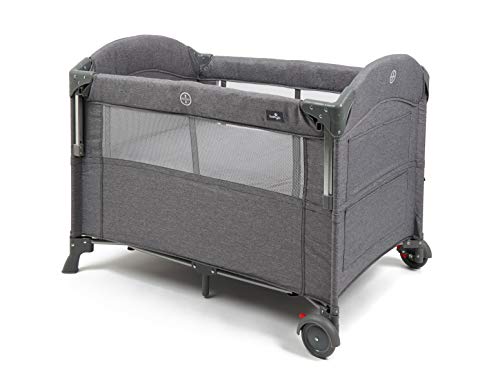11 “Faux Pas” That Are Actually Acceptable To Make With Your Bedside Cot For Infants
The Importance of Bedside Cots for Infants: A Comprehensive Guide
As new parents embark on their parenting journey, they are challenged with a myriad of choices concerning their infant's sleep arrangements. Among these choices, the bedside cot stands apart for its myriad of benefits. This short article explores the significance of bedside cots, discusses their benefits and drawbacks, answers often asked concerns, and consists of a relative table to assist parents make notified decisions.
What Is a Bedside Cot?
A bedside cot is a sleep space created to be placed next to the parents' bed, enabling easy access to the infant throughout the night. These cots feature adjustable height settings, enabling them to align with the height of the adult bed. Typically, they can be attached firmly to the bed or stay nearby, providing a safe yet accessible sleep environment for the baby.
Types of Bedside Cots
- Co-Sleeping Cots: These cots attach safely to the parents' bed, permitting close proximity while ensuring the baby has their own safe sleeping space.
- Freestanding Cots: These are positioned next to the bed however do not attach directly. They still provide a convenient reach for feeding and reassuring.
- Portable Cots: These cots are lightweight and created for travel, often featuring collapsible styles and easy-transport capabilities.
Advantages of Using a Bedside Cot
Bedside cots offer a number of advantages that can boost both the infant's sleep experience and the parents' comfort. These consist of:
1. Enhanced Safety
According to the American Academy of Pediatrics (AAP), having the infant sleep in the very same room as parents, without sharing the same sleeping surface, significantly reduces the risk of Sudden Infant Death Syndrome (SIDS). A bedside cot provides a safe space while keeping proximity.
2. Easier Nighttime Care
When a baby is within arm's reach, feeding, diaper changes, and comforting ends up being far more convenient. Parents can quickly soothe their infant without completely waking from sleep or leaving the bed.
3. Support of Bonding
The close distance provided by a bedside cot motivates bonding throughout nighttime feedings or soothing. This can foster a sense of security for the infant and help develop stronger emotional connections.
4. Space-saving Design
Lots of bedside cots are developed to be compact, making them perfect for small home where a full-sized crib may not fit. They can be easily moved or stored when not in use.
5. Versatile Functionality
Most bedside cots can be changed in height and often include removable sides, making them adaptable for various usages as the child grows or family requires modification.
Downsides of Bedside Cots
In spite of their benefits, there are some drawbacks to consider when picking a bedside cot:
1. Limited Lifespan
Bedside cots usually have a shorter life-span than standard cribs, often accommodating infants just up to a specific weight or height. Parents may require to shift to a complete crib faster than prepared for.
2. Stability Concerns
If not firmly connected or effectively placed, a bedside cot may present safety concerns. Parents must guarantee that the cot is steady and well-aligned with the bed.
3. Modification Period
Some infants may require time to get used to sleeping in a cot, especially if they are used to closer contact. Parents might need to be patient as their kid adapts.
How to Choose the Right Bedside Cot
When selecting a bedside cot, parents need to consider the following criteria:
- Safety Standards: Ensure the cot adheres to all safety regulations.
- Adjustability: Look for height-adjustable functions that align with your bed.
- Construction Material: Choose a cot that is sturdy and made of non-toxic products.
- Reduce of Use: Opt for designs that enable one-handed operation when accessing the infant.
Table: Comparison of Popular Bedside Cots
Function
Co-Sleeping Cot
Freestanding Cot
Portable Cot
Attachment to Bed
Yes
No
No
Adjustability
Yes
Yes
Yes
Travel-Friendly
No
No
Yes
Life expectancy
6-12 months
18-24 months
0-12 months
Cost Range
₤ 150-₤ 300
₤ 100-₤ 250
₤ 50-₤ 150
Often Asked Questions (FAQs)
1. just click the up coming post cots safe for my baby?
Yes, when utilized correctly and according to security requirements, bedside cots are safe for infants. It is vital to make sure that the cot is securely positioned and does not pose any threat of falling.
2. At what age can I shift my baby from a bedside cot to a crib?
A lot of parents shift their baby from a bedside cot to a crib between six months and 2 years, depending upon the infant's development and convenience level.
3. Can I use a bedside cot for twins?
While some bedside cots are designed to accommodate more than one child, the majority of are meant for single infants. Parents of twins may need to think about utilizing separate cots.
4. How do I maintain my bedside cot?
Routine cleansing, checking for wear and tear, and guaranteeing that all components, such as safety straps and bed mattress, remain in excellent condition, can assist keep your bedside cot.
Choosing the ideal sleep plan for an infant is one of the many choices that new parents face. A bedside cot offers unrivaled convenience and security while enabling for close adult interaction. Comprehending the benefits, drawbacks, and features of bedside cots can empower parents to make the best option for their household's needs. By weighing these aspects together with safety precautions, parents can develop a nurturing sleep environment for their kids.
